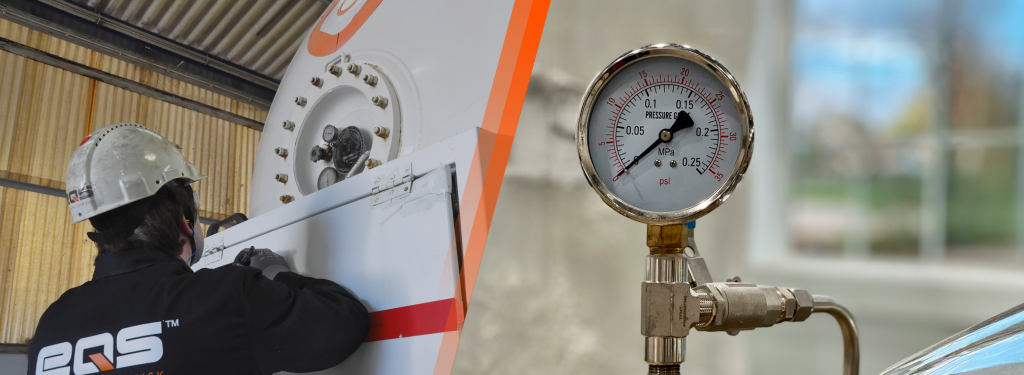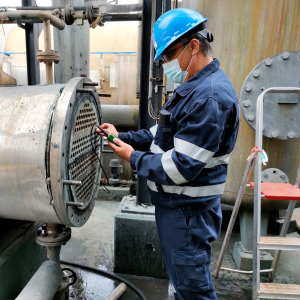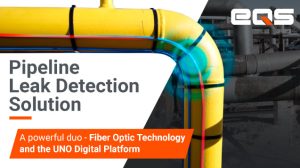
CE marking: European directive for the compliance of pressure equipment
The CE marking for pressure equipment is a legal requirement for the manufacture and distribution of pressure equipment in the European Union, guaranteeing that these products meet the highest standards of safety and quality. Compliance checks ensure that manufacturers meet the required technical standards, promoting confidence in the market and the safety of users.
Given the importance of this European directive (PED 2014/68/EU), we spoke to Fernando Ferreira, Business Unit Manager at EQS | a Kiwa company, who explains the importance of this directive, the certification process, the role of EQS as a notified body, among other key topics on the subject.

Fernando Ferreira
Business Unit Manager
What is CE marking and what equipment does this European directive cover?
The CE marking covers all equipment and assemblies whose maximum permissible pressure is greater than 0.5 bar. Any equipment operating above this pressure must have a Declaration of Conformity, which proves compliance with the European directive and harmonized standards.
To ensure compliance, all pressure equipment must undergo a check of the applicable requirements. Only once it has been confirmed that it meets all the requirements can it be CE marked.
What is the role of this European directive? Why is it important?
European directives are created to essentially guarantee the safety of equipment, people and the surrounding environment, etc. with the aim of protecting all those who operate and sell this equipment. European Directive 2014/68/EU, which regulates pressure equipment, is adopted by each member country of the European Union and adapted to national legislation. In the case of Portugal, this directive gave rise to Decree-Law 111-D/2017.
The main benefit of CE marking is that it guarantees that the equipment complies with these manufacturing standards. Most pressure equipment in Europe is required to have this marking, and even if the intervention of a notified body is not required, the manufacturer must issue a Declaration of Conformity.

When a notified body assigns the CE marking, it issues a certificate of conformity, and the manufacturer, in addition to receiving this certificate, must also issue its own Declaration of Conformity and reference the document issued by the body. All this serves to ensure that the equipment is able to be marketed in accordance with the European Union’s safety requirements.
What specific technical requirements must pressure equipment meet in order to obtain CE marking?
Each piece of pressure equipment has to meet specific technical requirements that are defined based on the characteristics of the project.
The process begins with an analysis of the project, where the characteristics of the equipment are confirmed, to determine which compliance module the equipment falls into and its risk class. From there, the specific technical requirements that the equipment must meet, the responsibilities of the manufacturer, and the Notified Body are established, thus ensuring that it meets the safety and quality standards required for CE marking.
Which companies should follow this directive? What steps does the process involve?
This directive applies to all companies that manufacture pressure equipment. When they receive a request from a customer, they must fit the equipment into one of the CE Marking conformity modules, taking into account factors such as the maximum admissible pressure, the volume and the type of fluid. Let’s take the example of pressure equipment with a total volume of 10,000 liters, operating with water at 190°C, at a maximum pressure of 20 bar. This is the information that the manufacturer uses to consult the directive, determine the compliance module and risk class that the equipment falls into, and define its responsibilities to ensure that the product complies with all safety regulations.
From here, always depending on the module of conformity and the characteristics of the equipment, the manufacturer may need to contract a notified body, which carries out the necessary assessments to award the CE marking.
As a notified body, EQS, part of the Kiwa group, is accredited to carry out CE marking on pressure equipment.
It is also important to understand that there is a difference between CE marking, which involves a formal assessment by a notified body, and the Declaration of Conformity. This declaration of conformity is a requirement for the manufacturer to issue. Both are necessary to ensure that the equipment complies with the directive.
As a notified body, how does EQS operate? What tasks do we carry out to ensure the conformity of this type of equipment?
As a notified body, EQS follows a process made up of several essential tasks to guarantee the compliance of pressure equipment.
For example, we are responsible for validating the project, the Inspection and Test Plan, evaluating the materials used, verifying their traceability, etc. We witness tests and other inspections, ensuring that the equipment meets the expected requirements. We also carry out dimensional control of the equipment to ensure that it complies with the design. We analyze the manufacturing dossier, which includes reviewing various documents.
One of the main points of manufacturing is the pressure test, which is carried out to assess the mechanical strength of the equipment. This test is carried out at a pressure which is determined according to the maximum working pressure and the maximum temperature, following the construction code used.
How often does pressure equipment need to be evaluated?
The frequency with which pressure equipment is assessed depends on the type of compliance module. Most pressure equipment is manufactured to order, meaning that each piece of equipment has specific characteristics. When these differences exist, the equipment must be assessed individually.
As a notified body, EQS is responsible for carrying out final inspections and monitoring the equipment.
What are the main penalties for non-compliance with this directive / decree law?
There are various penalties laid down in the Portuguese Decree-Law for non-compliance of pressure equipment. These penalties include fines, which can differ depending on the seriousness of the situation, and, in the case of serious infractions, even criminal penalties. Responsibility for applying these sanctions lies with the ASAE General Inspection, which monitors and ensures compliance with the rules on equipment safety and conformity.



